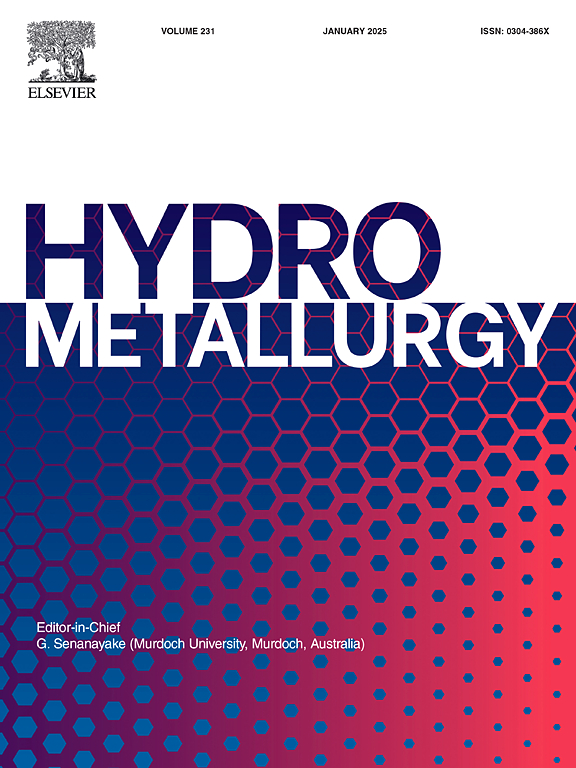Selective indium extraction from zinc oxide dust leachate by microwave-assisted solvent extraction with P507 and stripping with HCl: Thermodynamics and kinetics
IF 4.8
2区 材料科学
Q1 METALLURGY & METALLURGICAL ENGINEERING
引用次数: 0
Abstract
In this work, indium was extracted from zinc oxide dust leachate using a microwave-assisted P507 extractant, and microwave-assisted indium stripping with hydrochloric acid. The effects of extractant concentration, pH, volume ratio of organic phase to aqueous phase, contact time, temperature and microwave power on indium extraction were investigated. The optimum conditions for indium extraction were obtained as follows: extractant concentration, 25 % (v/v) in sulphonated kerosene; pH = −0.2; O/A (volume ratio of organic phase to aqueous phase) = 1:2; contact time, 2 min; temperature, 40 °C; and microwave power, 70 W. Under these conditions, the extraction efficiencies of indium, zinc, iron and aluminium were 97.6 %, 2.50 %, 0.48 % and 0.89 %, respectively. The separation coefficients of indium for zinc, iron and aluminium were 1333, 7996 and 4442, respectively, which indicated that P507 has good selectivity for indium over zinc, iron and aluminium. The optimum conditions for indium stripping were a hydrochloric acid concentration of 1.5 mol/L, O/A = 2:1, contact time of 3 min, temperature of 40 °C and microwave power of 90 W, under which the indium stripping efficiency was 99.1 %. Additionally, McCabe–Thiele diagrams were constructed for indium extraction by P507 and indium stripping by hydrochloric acid, which theoretically predicted two stages for indium extraction by P507 and only one stage for indium stripping by hydrochloric acid. The advantage of microwave extraction over conventional extraction was that it reduced the time required for the extraction to reach equilibrium. The stoichiometric data for the extraction reactions were determined using the slope method. Thermodynamic studies showed that microwave-assisted indium extraction was feasible, with all negative standard Gibbs free energies, and the introduction of microwaves increased the entropy change of the extraction reaction. Kinetic studies showed that microwave-assisted In(III) extraction followed a pseudo-second-order kinetic model. The mechanism of In(III) extraction involves ion exchange with hydrogen in -P-O-H in P507. The future studies will focus on the amplification of microwave extraction equipment to promote industrialisation.
微波辅助P507溶剂萃取和盐酸汽提从氧化锌粉尘渗滤液中选择性提取铟:热力学和动力学
本研究使用微波辅助 P507 萃取剂从氧化锌粉尘浸出液中萃取铟,并使用盐酸进行微波辅助铟汽提。研究了萃取剂浓度、pH 值、有机相与水相的体积比、接触时间、温度和微波功率对铟萃取的影响。在这些条件下,铟、锌、铁和铝的萃取效率分别为 97.6%、2.50%、0.48% 和 0.89%。铟对锌、铁和铝的分离系数分别为 1333、7996 和 4442,这表明 P507 对铟、锌、铁和铝具有良好的选择性。铟汽提的最佳条件是盐酸浓度为 1.5 mol/L、O/A = 2:1、接触时间为 3 分钟、温度为 40 ℃、微波功率为 90 W,在这些条件下,铟的汽提效率为 99.1%。此外,还绘制了 P507 萃取铟和盐酸剥离铟的 McCabe-Thiele 图,从理论上预测了 P507 萃取铟的两个阶段和盐酸剥离铟的一个阶段。与传统萃取相比,微波萃取的优势在于缩短了萃取达到平衡所需的时间。萃取反应的化学计量数据是用斜率法测定的。热力学研究表明,微波辅助铟萃取是可行的,标准吉布斯自由能均为负值,微波的引入增加了萃取反应的熵变。动力学研究表明,微波辅助铟(III)萃取遵循伪二阶动力学模型。In(III) 的萃取机理涉及 P507 中 -P-O-H 的氢离子交换。今后的研究将侧重于微波萃取设备的放大,以促进工业化。
本文章由计算机程序翻译,如有差异,请以英文原文为准。
求助全文
约1分钟内获得全文
求助全文
来源期刊

Hydrometallurgy
工程技术-冶金工程
CiteScore
9.50
自引率
6.40%
发文量
144
审稿时长
3.4 months
期刊介绍:
Hydrometallurgy aims to compile studies on novel processes, process design, chemistry, modelling, control, economics and interfaces between unit operations, and to provide a forum for discussions on case histories and operational difficulties.
Topics covered include: leaching of metal values by chemical reagents or bacterial action at ambient or elevated pressures and temperatures; separation of solids from leach liquors; removal of impurities and recovery of metal values by precipitation, ion exchange, solvent extraction, gaseous reduction, cementation, electro-winning and electro-refining; pre-treatment of ores by roasting or chemical treatments such as halogenation or reduction; recycling of reagents and treatment of effluents.
 求助内容:
求助内容: 应助结果提醒方式:
应助结果提醒方式:


